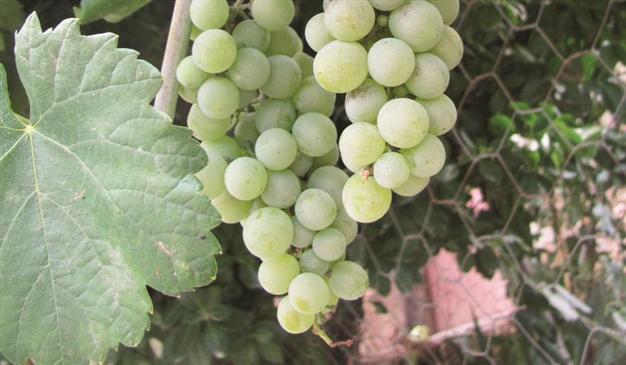Silky seduction
AYLİN ÖNEY TAN - aylinoneytan@yahoo.com
 Rolled and wrapped leaves stuffed with various fillings are the most distinctive dishes of Turkish cookery. Wrapped leaves of all kinds, the ubiquitous yaprak sarma, especially of grapevines, appear on the table either as a meze, or as a main dish, undoubtedly in all corners of the country. Viticulture in Anatolia is not only about grapes and wines, but also about a whole range of other products both from the fruit and especially the leaves of the vine. Yaprak is the name for any leaf, and vine-leaves are also simply called yaprak, without a reference to the plant itself.
Rolled and wrapped leaves stuffed with various fillings are the most distinctive dishes of Turkish cookery. Wrapped leaves of all kinds, the ubiquitous yaprak sarma, especially of grapevines, appear on the table either as a meze, or as a main dish, undoubtedly in all corners of the country. Viticulture in Anatolia is not only about grapes and wines, but also about a whole range of other products both from the fruit and especially the leaves of the vine. Yaprak is the name for any leaf, and vine-leaves are also simply called yaprak, without a reference to the plant itself. It must be the use of grape leaves that is so unique about Anatolian regional cuisines. Sarma, meaning wrapped or enveloped, is a generic name to all stuffed leaf-based dishes. Despite relatively a small wine industry, Turkey ranks sixth in world grape production. Only a few percent goes into the bottles, but a lot is consumed fresh or turned into grape juice. The greatest portion ends up being dried grapes of all types, especially raisins and sultanas, or turned into pekmez, grape molasses, and its byproducts like pestil, grape leather, or sucuk, the walnut filled sweetmeats. Apart from all those grape products, the hidden crop of the vineyards is the leaves. The tender, young leaves of the grapevine is a major food item in Turkey, sold in markets like spring vegetables. There is even a rolling device developed to make sarma, but the hand rolled way is like the honor and pride of the Anatolian house-wife.
It must be noted that, leaves used in cooking are not restricted to vine leaves. Of course there is the whole category of leafy vegetables like cabbages or chard, and foraged wild greens like rumex or mallow. Not widely recognized in cities, but much appreciated in the rural areas, is the use of young leaves of various fruit trees in cooking. Many fruit leaves like cherries, sour cherries, quinces, even nuts like hazelnuts and horse-chesnuts give their distinctive taste to dishes. The cherry leaf wrapped dish of Malatya is a taste to die for. Stuffed with no meat, but a mixture of raw cracked wheat, and laden with a thick layer of caramelized onions, poured with melted butter and garlic yogurt, it is a taste to experience. The distinctive bitter almond flavor of the cherry penetrates into the filling through the leaves, and creates the unique taste reminiscent of the fruit itself. The very same dish is also prepared with the leaves of the white mulberry, ending up in a dish faintly sweet and silky smooth, again resembling the fruit and the tree, which is strangely related to silk production. Morus alba, the white mulberry tree is the natural habitat of silkworms.
Where ever there is a sizable mulberry production, there must be a history of silk weaving. The Latin name for silkworm, Bombyx mori actually mean “Silkworm of the mulberry tree”, the mulberry leaves being the sole source of food for silkworms.
Now it is the season for white mulberries, “dut” in Turkish, a delicate, soft white berry making its appearance in markets for a regrettably short period. So it is time to enjoy both the fruit and if one can get near to a tree, of the tenderest leaves to wrap.
Go out in the countryside or in parks; Keep looking for a Morus alba tree, and keep rolling!
Bite of the week
Recipe of the Week: Crisp fried vine-leaves are perfect to go with a crisp white wine. It is a miraculously wonderful nibble for the happy hour, making you happy you if you like crisps. The best is to fry the fresh leaves but even the brined leaves make a good crunch. Simply blot the brined leaves with a paper cloth and deep fry in plenty of olive oil, taking care not to break them. Transfer onto paper towels and arrange loosely in a shallow basket to serve. They’re especially pretty with cheese plates with a bunch of grapes and some walnuts!
Fork of the Week: Frankie in Nişantaşı has the most exciting tiny morsel of vine-leaves plus a soup. A tiny wrapped sarma, skewered on a toothpick, is balanced over a small glass of frothy venom green soup made with Chardonnay leaves. Don’t let the deep green color frighten you, the taste is heavenly and the yogurt foam on top is like a kiss of an angel. They give their tasty “Chardonnay Yaprak Çorbası” as an amuse-bouche but if you ask for more you can get a whole serving as a starter. This is the most innovative yaprak dish so far in modern Turkish cooking.
Cork of the Week: The best wrapping vine-leaves come from the Narince grapes of Tokat. Another trivia to know is for wrapped dishes, it is always white grape leaves when available. Narince is a delicate thin-skinned indigenous white grape producing delicate balanced fine whites. One Narince to enjoy with your vine-leaf crisps is a Diren Collection Narince by Diren winery , the local wine producer of Tokat, one of the pioneers in Anatolian wine scene.












